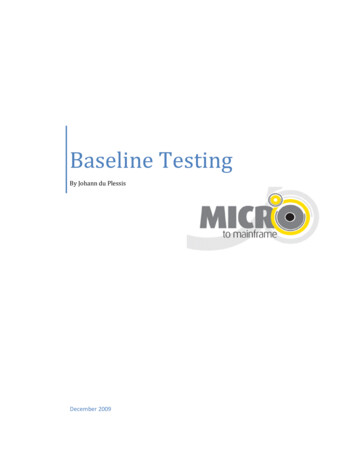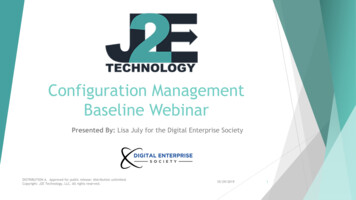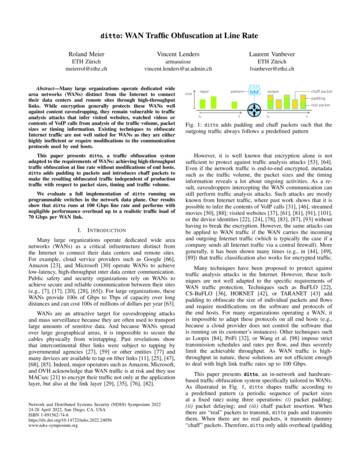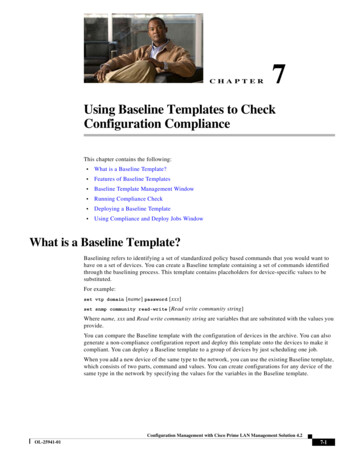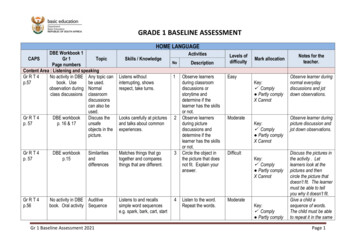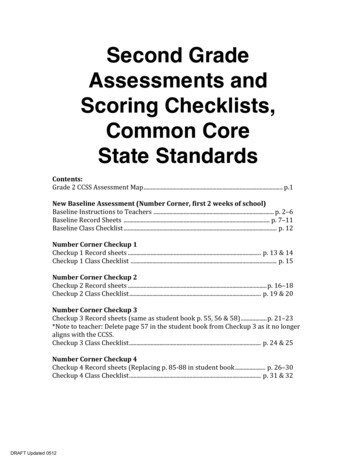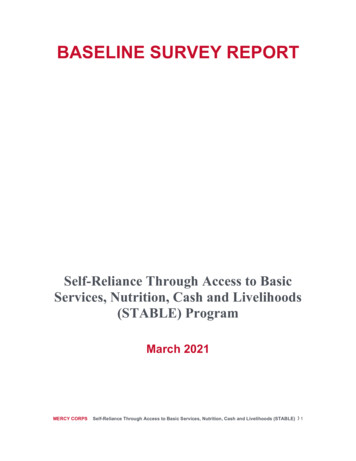
Transcription
BASELINE SURVEY REPORTSelf-Reliance Through Access to BasicServices, Nutrition, Cash and Livelihoods(STABLE) ProgramMarch 2021MERCY CORPSSelf-Reliance Through Access to Basic Services, Nutrition, Cash and Livelihoods (STABLE)1
Table of ContentsAcronyms31. Introduction41.1 Objective of the baseline survey52. Executive Summary53. Study Methods73.1. Baseline Methodology73.1.1. Introduction73.1.3. Data Collection Instruments73.1.4. Limitations of the Baseline Study83.2. Survey Coverage - Location and Timing84. Results and Findings94.1 Data Analysis94.2 WASH94.2.1 WASH Infrastructure104.2.2 Training114.2.3 Hygiene124.3 Food Security and Livelihoods124.4 Multi-Purpose Cash Assistance124.5 Nutrition145. Conclusion and Recommendations15Annexes16MERCY CORPSSelf-Reliance Through Access to Basic Services, Nutrition, Cash and Livelihoods (STABLE)2
ASHCommunity Accountability Reporting MechanismFocus Group DiscussionFood Security and LivelihoodsHumanitarian Aid CommissionHouseholdInternally Displaced PersonInfant and Young Child FeedingKey Informant InterviewMonitoring, Evaluation and LearningMulti-Purpose Cash AssistanceNon-Food ItemsOpen Data KitPost-Distribution MonitoringWater, Sanitation, and HygieneMERCY CORPSSelf-Reliance Through Access to Basic Services, Nutrition, Cash and Livelihoods (STABLE)3
1. IntroductionSouth Kordorfan State continues to face interconnected humanitarian challenges due to the impact of10 years of conflict and the continued presence of armed groups. Despite the preliminary agreementsigned between government forces and the Sudan People’s Liberation Movement-North (SPLM-N) toextend the ceasefire and start a mediation process towards a final peace deal, the conflict hascontinued in the two areas of Kordorfan and Blue Nile, which has undermined access to basic servicesand livelihoods for both host communities and Internally Displaced Persons (IDPs).The ongoing economic crisis in Sudan has continued to undermine household food security 1 with themajority of IDPs and host community unable to meet their basic water, sanitation, nutrition, foodsecurity and livelihood needs. While the transitional government is committed to stemming theeconomic crisis, government reforms may involve drastic economic measures such as food and fuelsubsidy cuts that could further impact families who are already struggling to cope. The deterioratingeconomic situation has affected emergency food assistance, for which the caseload is high due toelevated staple food prices and insufficient income. The increase in staple food prices has beenexacerbated by a high rate of inflation. Poor access to safe and clean water has also exacerbatedmalnutrition cases among the IDPs and host community members.The COVID-19 pandemic also poses a threat to household livelihoods, the functioning of markets, aswell as direct impacts on health. Moreover, the spread of COVID-19 may increase the risk of mortalityfor populations whose health status is already compromised by acute malnutrition 2 as a result of foodinsecurity.While the full impact of the evolving operating environment on the humanitarian situation is unclear,the transitional government of Sudan has been supportive of the international humanitariancommunity, including INGOs. The process of obtaining technical agreements, visas and travel permitsfrom state and federal Humanitarian Aid Commission (HAC) has become more efficient in 2020compared to the previous years when the process would take more than three months, even thoughthe labor department remains actively involved in the INGO national staff recruitment process includingscreening and selection.To alleviate the ongoing humanitarian situation and the spread of COVID-19, Mercy Corps requested 1,700,000 USD to implement an integrated WASH, nutrition, food security and livelihoods programfor twelve months in South Kordorfan State, supporting 46,634 individuals (8,570 men, 9,106 women,14,398 boys and 14,560 girls). Additional time and resources will enable Mercy Corps to meet theurgent needs of households in South Kordorfan State by increasing their access to basic WASHservices and nutrition, while strengthening the foundation for future recovery through increasedlivelihood opportunities. This program will also support the ongoing global and national efforts forcombatting the COVID-19 pandemic that is currently ravaging communities and individuals.To monitor the progress of implementation of program activities and their effect on targetedcommunities, households and individuals, Mercy Corps developed a detailed Monitoring andEvaluation (M&E) plan (Annex 2) incorporating a log frame. The M&E plan for the program providesdata to inform decision-makers in order to optimize the program’s implementation as well as to providemeasurable indications of the program’s achievements of the program activities Thus, the baseline1Sudan Humanitarian Needs Overview – OCHA, January 20202FEWS NET Sudan Food Security Outlook, February 2020 to September 2020MERCY CORPSSelf-Reliance Through Access to Basic Services, Nutrition, Cash and Livelihoods (STABLE)4
survey provides initial characterization of the conditions related to program interventions and whereapplicable, provide initial baseline values of some of the program indicators which will be the basis fordetermining changes and impact at the end of the program.1.1 Objective of the baseline surveyThe main objective of this baseline assessment exercise was to capture data and information thatwill enable the project to establish the prevailing situation in the targeted villages and householdsabout WASH, Agriculture and Nutrition. The specific objectives of the baseline survey were: To collect data that will be able to determine the level of change on impact and outcomeindicators between baseline and final evaluation; Improve the understanding of constraints and challenges faced by target participants, andtheir current state of needs.2. Executive SummaryProject NameSelf-Reliance Through Access to Basic Services,Nutrition, Cash and Livelihoods (STABLE)Project LocationSouth Kordorfan StateProject Duration12 months (September 2020 to August 2021)Project BudgetUSD 1,700,000DonorsUSAID - Bureau of Humanitarian Affairs (BHA)Implementing AgencyMercy Corps-SudanMercy Corps is implementing a 12-month USAID award jointly funded by the Bureau of HumanitarianAffairs (BHA) to support an integrated WASH, nutrition, food security and livelihoods program in SouthKordorfan State, supporting 46,634 individuals (8,570 men, 9,106 women, 14,398 boys and 14,560girls).Additional time and resources will enable Mercy Corps to meet the urgent needs of households inSouth Kordorfan State by increasing their access to basic WASH services and nutrition, whilestrengthening the foundation for future recovery through increased livelihood opportunities. Thisprogram will also support the ongoing global and national efforts for combatting the COVID-19pandemic that is currently ravaging communities and individuals.Mercy Corps-Sudan MEL Unit together with Programs Teams took the lead to conduct the baselinestudy of the households targeted by the project. The baseline study aims to provide an independentlyassessed information base relevant to the project against which the project’s progress andeffectiveness can be monitored and assessed. The study has attempted to capture the currentcondition of the project beneficiaries looking at the following: Current rehabilitation needs of water hand pumpsCurrent knowledge of hand washing practicesMERCY CORPSSelf-Reliance Through Access to Basic Services, Nutrition, Cash and Livelihoods (STABLE)5
Key sources of food for household consumptionBenefits of FSL assistance receivedAccess to key agricultural inputsSources of household incomeNutrition services availabilityA summary of the findings related to these indicators can be found at the end of this executivesummary section.The methodology used for the study involved both primary and secondary research. Primary researchconsisted of all data collected during the registration of participants between 15 March and 23 March2021.The MEL Unit together with programs developed a questionnaire tool on the basis of the Projectproposal and the MEL Narrative. Data from 362 respondents in four localities of South Kordofan Statewas collected and analyzed. A scoping study or pre-test was carried out to test and refine all toolswhich were used with sample respondents from the project areas.Secondary research involved the MEL Team reviewing key project documents such as projectproposals, WASH feasibility assessments and M&E framework.Findings reveal that the average household age was 38.2 years - 40.6 for male heads of householdand 36.1 for female household heads. The majority of household heads surveyed in the dataset weremale (62%).Over 70% of the respondents reported that there are non-functional hand pumps in their localitiesthat need repair or rehabilitation, with an almost similar majority of them reporting that no youth fromtheir areas had been trained on hand pump maintenance or repair. These findings indicate that thereis indeed a need for support in the repair of water infrastructure and building of the community’scapacity to maintain them. A majority of those sampled (93%) reported never having been trained onhygiene promotion. Those who had received the training mainly received WASH skills, leadershipand communication skills training. No follow-up training was provided after the first one. In thisSTABLE program, comprehensive training with follow-up training and training assessments will beconducted to ensure provision of a comprehensive WASH hygiene promotion support. Growing ontheir own land and purchasing from local shops were identified as the main sources of attaining foodby 58% and 41% of sampled respondents respectively, while 1% source their food through directpurchasing from local traders. For those who reported growing their own food, a large majority (81%)indicated that they do own the land on which it is cultivated, while (69%) also reported that they hadnever received any kind of support with seeds and/or tools from any NGO.A few (4%) reported that they are currently receiving some cash assistance from NGOs in the area,highlighting the need for more cash interventions in these localities. Although there are somenutrition services available in the localities, only 11% of the respondents have participated in theInfant and Young Child Feeding sensitization (IYCF) initiatives signifying a need for moresensitization efforts in ICYF in the operational areas. The protection, promotion and support of IYCFsensitization efforts are central to preventing all forms of child malnutrition, including stunting andwasting as well as overweight and obesity thereby improving nutrition outcomes which is one of theobjectives of the STABLE program within the target localities.MERCY CORPSSelf-Reliance Through Access to Basic Services, Nutrition, Cash and Livelihoods (STABLE)6
3. Study Methods3.1. Baseline Methodology3.1.1. IntroductionThe baseline survey design used a mix of quantitative and qualitative methods to establish baselinevalues and characterize the current situations regarding food security, nutrition and WASHinterventions. The household-level quantitative survey was applied to all randomly selected potentialprogram participants in four localities of South Kordorfan State. The survey can be found in Annex 1.Among all target groups, Mercy Corps will apply the following minimum targeting parameters that arein line with Mercy Corps’ current resilience programming: 25% women, 10% people with disabilitiesand older people. Mercy Corps’ beneficiary selection Standard Operating Procedures (SOPs) definethe standard vulnerability scoring and beneficiary selection process for MPCA and other programinterventions. The selection criteria include: Household (HH) sizeHousing type and current status of residenceHousehold dependency ratioGender and age of Household headPerson living with special needsChronically ill peoplePregnant/lactating women in the houseHousehold monthly estimated incomeFollowing the initial staff training and a pilot of the survey tool on March 17, 2021 in Kadugli locality,the survey deployment was conducted under the BHA STABLE award3.1.2. Sampling Design and ProceduresThe MEL team began the household surveys using the survey tool on March 18 and all data from thesurveys conducted from that date through March 23 were used as part of the baseline report. Thesurveys were conducted in the following areas: Kadugli locality (Alshaeer Masker, Morta East,Algardod, Almokhaymat and Tafery); Elriefsarqi (Saraf Alday, Sudia, Barno, Gabrona, AlshaeerTomat); Dilling (Altemaid, Gadra, Almrafeid, Alsir alameen, Kondomaya, Umashosh and Albok) andRashad (Rashad City, Sangel, Tortag, Alnemaya, Khoralramla, Kaloba and Saraf Falata)All HHs assessed were in-camp IDPs, returnees, or members of host communities. Mercy Corpsconducted the surveys using a blanket, door-to-door method. With the total target population ofbeneficiaries being 100,433 people, a tentative sample size of 384 individuals was derived (95%Confidence Level, 5% Confidence Interval) using a normal online sample size calculator.3.1.3. Data Collection InstrumentsThe baseline survey used a registration survey tool (Annex 1) that collected information on thefollowing: Socio-demographic characteristics of householdsAccess to WASH ServicesHousehold Agriculture and Food Security StrategiesAccess to Nutrition ServicesMERCY CORPSSelf-Reliance Through Access to Basic Services, Nutrition, Cash and Livelihoods (STABLE)7
The quantitative household survey (registration) was conducted with tablets using an open data kit(ODK). The completed surveys were all uploaded onto Ona platform on a daily basis. The uploadedsurveys were then downloaded into Excel for ease of data cleaning and analysis.3.1.4. Limitations of the Baseline StudyThe surveys were conducted using a door-to-door approach to enhance the ability for in-personverification of household circumstances. Data is self-reported by participants, can be subject to "overreporting." This can sometimes lead to an exaggeration of household circumstances in efforts toreceive more assistance, as households may present their situation as ‘worse-off’. To mitigate overreporting on crucial variables, Mercy Corps trained the enumerators on how to explain the purpose ofthe surveys and its objectives so as not to raise expectations of the respondents, and to triangulatesome of the information with direct observation of key information such as types of water sources andthe distance to the sources from the homestead.The baseline survey was delayed due to the fixed exchange rate situation in Sudan before March2021, which led to very high costs to implement the survey prior to this date. This exchange rate policywas however changed later in the month, providing a limited time to collect the data including FocusGroup Discussions (FDGs) and Key Informant Interviews (KIIs). Given the limited time, KIIs and FDGscould not be conducted, as the survey was undertaken in about 10 days through only householdinterviews.3.2. Survey Coverage - Location and TimingMercy Corps conducted 381 surveys during the period of March 17 – March 23, 2021. The surveystook place in four localities across South Kordofan State. A full list of the number of surveys per localityis shown below:StateLocalityVillagesKadugliAlshaeer Masker,Morta East, Algardod,Almokhaymat andTafery97Alreef AlsharqiSaraf alday, Sudia,Barno, Gabrona,Alshaeer Tomat67DillingAltemaid, Gadra,Almrafeid, Alsiralameen, Kondomaya,Umashosh and Albok99RashadRashad City, Sangel,Tortag, Alnemaya,Khoralramla, Kalobaand Saraf Falata99South Kordorfan StateNumber of SurveysTotalMERCY CORPS362Self-Reliance Through Access to Basic Services, Nutrition, Cash and Livelihoods (STABLE)8
4. Results and Findings4.1 Data AnalysisAll data was collected digitally and uploaded to a central, aggregate platform using Ona. The data wasthen downloaded into Microsoft Excel, and cleaned by the Database Officer in coordination with theSenior MEL Officer and MEL Manager. Frequency tables, measures of central tendency and chartswere generated to show frequency and percentages of variables.This baseline survey covered 362 households in four localities of South Kordofan State. The surveyresults indicated that 46% of respondents were male and 54% were female. About 16% of respondentswere IDPs, while 77% were residents/hosts and the remainder were returnees (7%). The average ageof the respondents was 38.2 years, within a range of 14 to 82 years. The table below shows therespondent, head of household and household details.Number (%)NMeanMinMax38.2148239.3715102362 (100%)RespondentMale167 (46%)Female195 (54%)AgeHead of householdMale150 (62%)Female91 (38%)AgeResident/hostcommunity280 (77%)IDP58 (16%)Returnee24 (7%)4.2 WASHWith respect to the main water sources for daily domestic use, the sampled respondents indicatedthat a majority of them (70%) use hand pumps for this purpose. Open well and piped wateraccounted for 22% and 4% of respondents respectively. About 4% highlighted that they use othersources of water that includes streams, shallow wells or rivers. A large majority (62%) also reportedthat they were not aware of any committees established or functioning in their areas for the purposeof championing WASH activities, with 59% also indicating that they (or members of their HH) werenot active in any of the present WASH committees.MERCY CORPSSelf-Reliance Through Access to Basic Services, Nutrition, Cash and Livelihoods (STABLE)9
4.2.1 WASH InfrastructureNearly 70% of the respondents reported that there are non-functional hand pumps in their areas thatneed repair or rehabilitation, with an almost similar majority of them reporting that no youth from theirareas had been trained on hand pump maintenance or repair. These findings indicate that there isindeed a need for support in the repair of water infrastructure and building of the community’scapacity to maintain the same.A Distribution of Daily Water Sources Used in Areas ofImplementation21.82%4.42%3.87%69.89%open wellotherpiped waterwater pumpOn average, the respondents highlighted that there were non-functional hand pumps per localityalthough these varied per village. For comprehensive analysis of the non-functional hand pumps pervillage. Please see Annex 2 from the feasibility assessment.MERCY CORPSSelf-Reliance Through Access to Basic Services, Nutrition, Cash and Livelihoods (STABLE)10
Over 50% of respondents noted that they have to travel less than 1km to the nearest water pointsavailable in the localities. However, on average about 42% (range of 26% to 44%) of the respondentshighlighted that they have to travel 1–3 km to access water. On average, about 10% have to travel atleast 3km to access water.4.2.2 TrainingA majority of those sampled (93%) reported never having been trained on hygiene promotion, whilefor those who had received some training. The WASH training covered topics on sanitation, hygiene,and waste management as well as personal hygiene.MERCY CORPSSelf-Reliance Through Access to Basic Services, Nutrition, Cash and Livelihoods (STABLE)11
4.2.3 HygieneOf the sampled respondents, 81% indicated that they are aware of how, when and how many timesthey should be washing their hands every day. However, upon further inquiry, almost 55% of therespondents stated that they should wash their hands about 1-4 times a day, in comparison to therecommended five times per day. This indicates that there is still a need for more sensitizationaround normal hygiene practices.4.3 Food Security and LivelihoodsGrowing on their own land and purchasing from local shops were identified as the main sources offood by an estimated 58% and 41% of sampled respondents respectively, while 1% sourced theirfood through direct food aid from NGOs.Source of Food for Household Consumption1.10%57.46%direct food aid from ngos41.44%growing on my own lanpurchasing from local traderFor those who reported growing their own food, a large majority (81%) indicated that they do ownthe land, while 69% also reported that they had never received any kind of support with seeds and/ortools from any NGO.This result shows that the areas targeted by the STABLE program are therefore well primed toreceive the agricultural interventions proposed by this program. A large majority of respondents(71%) reported that they do not feel like they have adequate access to seeds for planting.Conversely, about 34% of the respondents indicated that there are enough traders in their areaswho sell seeds and farming tools. This finding shows that the program team should endeavor todistinguish the geographically unique needs of the targeted populations, with respect to (improved)seeds and tools availability, during the anticipated distributions.4.4 Multi-Purpose Cash AssistanceAlmost a quarter of the sampled respondents indicated that they were currently involved in someform of income generating activities for their household needs. The exact income generatingactivities highlighted by this proportion of the respondents are illustrated by the graph below, whichshows that a majority of these rely on casual labor (49%), sales of farm produce or livestock (42%),and formal employment (9%).MERCY CORPSSelf-Reliance Through Access to Basic Services, Nutrition, Cash and Livelihoods (STABLE)12
Main Income Sources0.28%41.71%casual labor48.90%9.12%formal employmentsales of farm produce crops or livestocksmall business v cash transfer from ngoMain HH Expenditures1%1%3%94%educationfoodrentwater and sanitationOn average, the sampled respondents reported making about 12,723 SDG ( 40 USD) monthly. Themain expenditure cost is food, which accounts for 94% of total household income per month,indicating that food expenditures contain the bulk of their household expenses. Thus, participantsrequire support in terms of production of their own food through agricultural activities in order to havea significant portion of their income for other household expenses such as education, rent, etc.The respondents were also asked whether or not they are currently receiving cash assistance fromany NGO. A few (4%) reported that they are currently receiving some cash assistance from NGOs inthe area. This highlights the need for some cash interventions in the localities, as many of thesehouseholds struggle to meet their basic household needs with 94% of their monthly income goingtowards food.MERCY CORPSSelf-Reliance Through Access to Basic Services, Nutrition, Cash and Livelihoods (STABLE)13
4.5 NutritionThe assessment also asked information on the nutrition services available within the localities. 67%of the respondents noted that that were nutrition services available and about two thirds of theservices mentioned were Targeted Supplementary Feeding Program (TSFP) with the remainderbeing Outpatient Therapeutic Program (OTP).Although there are some nutrition services available in the localities, only 11% of the respondentsparticipated in the IYCF sensitization efforts, signifying a need for more awareness in ICYF in theoperational areas. 15% of the respondents were females who had children under five months of age.The survey elicited information from women with children under five on breastfeeding and otherfeeding practices. The following graph shows how they had fed their under-fives a day prior to thesurvey.From a nutrition perspective, children should be exclusively breastfed for the first six months of theirlives. This entails that no other liquids or solids are given (including water), with the exception of oralrehydration solution, or drops/syrups of vitamins, minerals or medicines. The survey results showthat about 70% of the respondents had breastfed their children under 5 months the day prior to thesurvey. However it is also worth noting that on average a third of the respondents had providedwater or some semi-solid food to their infants, which is not the recommended practice. It is thereforeimportant for the program to take note of these feeding practices and to conduct awarenesscampaigns on the nutritional aspects of the children under 5. This will need to be conducted with theState Ministry of Health.MERCY CORPSSelf-Reliance Through Access to Basic Services, Nutrition, Cash and Livelihoods (STABLE)14
5.Conclusion and RecommendationsBased on the findings of this assessment, the following points summarizes our recommendations onimplementation of the proposed project activities:1) There is an urgent need to address sanitation and hygiene services in all targeted villagesgiven the number of non-functional pumps in the localities and the long distances traveled toaccess water for the household.2) Multi-Purpose Cash Assistance (MPCA) needs to be implemented to complement the WASHactivities, as only 4% of respondents are currently receiving cash assistance in the surveyedareas. This will enable participants to meet their basic household needs during the leanseason and reduce their dependence on external assistance.3) There is a need to work closely with Line Ministries and other State level institutions toensure the sustainability of interventions, and ensure they are embedded within appropriatelocal structures.4) The Sudanese Government’s Water and Environmental Sanitation Department (WES),Sudan Ministry of Health, and local organizations should be engaged as partners in thedevelopment and management of water resources and health services in the rural villages.5) Capacity building of local partners, WASH committees, hygiene promoter groups and localauthorities should be a main focus of any implementation strategies for effectivemanagement of resources in the rural villages.6) Nutrition awareness and sensitization, including ICYF, must be added as part of the nutritionassistance within the localities. Very few respondents (11%) highlighted that they have beenpart of a sensitization effort within their areas, indicating a low level of nutrition awareness.MERCY CORPSSelf-Reliance Through Access to Basic Services, Nutrition, Cash and Livelihoods (STABLE)15
AnnexesAnnex 1 –Baseline ToolOFDA STABLE 33602 SKS BaselineHousehold/Individual QuestionnaireFebruary 20211. General Information1.1 Questionnaire Number 1.2 Date 1.3 Enumerator Name 1.4 Supervisor Name 1.5 Village/Camp Name . 1.6 State In what language do you feel most comfortable communicating?2. Household Socio-demographic Characteristics (Respondent Information)2.1 Respondent Name .2.2 Respondent Gender 2.3 Respondent Age 2.4 Respondent Contact/ID Number .2.5 Which best describes your household status?i.ii.iii.iv.; (Choose One)IDPReturneeHost CommunityRefugee2.6 Respondent’s Main Occupation; (Choose One)MERCY CORPSSelf-Reliance Through Access to Basic Services, Nutrition, Cash and Livelihoods (STABLE)16
i.ii.iii.iv.Animal RearingCasual LaborFarmingOther? Specify .Household Size? -------2.7 Is the respondent the head of the household?i.ii.YesNo2.8a Which of the following is your MAIN source of water for daily use (hint: cooking, drinking, bathingand washing)? (Choose ONE only)i.ii.iii.iv.v.Water PumpOpen WellRiver/StreamPiped WaterOther (Specify) .2.8b What is the distance between your household and the main water source?2.8c How long does it take to travel from your household to the main water source?2.8d What is the estimated total volume of water per day used on a normal day by all members of yourhousehold? How many 20 litres jerrycan do you fetch per day from all water sources? All sources"means any source, regardless of the quality of water, from which water is collected for the purpose ofsatisfying the drinking, cooking, and hygiene needs of household members. -------------XX Please state for me all of the occasions when it is most important to wash one's hands? (Please donot read this to respondents, Tick all that applies)Before eatingBefore preparing foodBefore feeding an infantAfter defecation/using the toiletAfter changing diapers or cleaning a child's bottom3. Access to WASH Services3.1 Does your household or community currently have access to an improved source of water forMERCY CORPSSelf-Reliance Through Access to Basic Services, Nutrition, Cash and Livelihoods (STABLE)17
drinking?i.ii.YesNo3.2 In your opinion, is the water you are currently using sufficiently clean (safe for drinking)?i.ii.YesNo3.3 Does your household or community currently have access to sufficient latrines or toilets to ensurethat there is no Open Defecation?i.ii.YesNo3.4 Do you feel like you have enough knowledge about hygiene and public health to adopt safe hygienepractices?i.ii.YesNo3.5 In your opinion, do you think the current WASH services adequately address women’s needs forprivacy, safety and appropriateness of services?i.ii.YesNo3.5 b Do you feel safe using or going to the water supply points that are in your community/area?(Yes/No)4. Access to WASH Infrastructure4.1 Are you aware of any Non-functional hand pumps in your area?i.ii.YesNo4.2 IF YES, Approximately how many of these Non-Functional hand pumps do you have in your area?( .)4.3 Are there any recently rehabilitated hand pumps in your Camp or Village?i.ii.YesNo4.4 If YES to 4.4. Above, in your opinion, have these rehabilitated pumps made it easier for thecommunity to access water?MERCY CORPSSelf-Reliance Through Access to Basic Services, Nutrition, Cash and Livelihoods (STABLE)18
i.ii.iii.YesNoN/a4.5 On average, how much time do you or members of your household use for fetch
1.1 Objective of the baseline survey 5 2. Executive Summary 5 3. Study Methods 7 3.1. Baseline Methodology 7 3.1.1. Introduction 7 3.1.3. Data Collection Instruments 7 3.1.4. Limitations of the Baseline Study 8 3.2. Survey Coverage - Location and Timing 8 4. Results and Findings 9 4.1 Data Analysis 9 4.2 WASH 9 4.2.1 WASH Infrastructure 10
